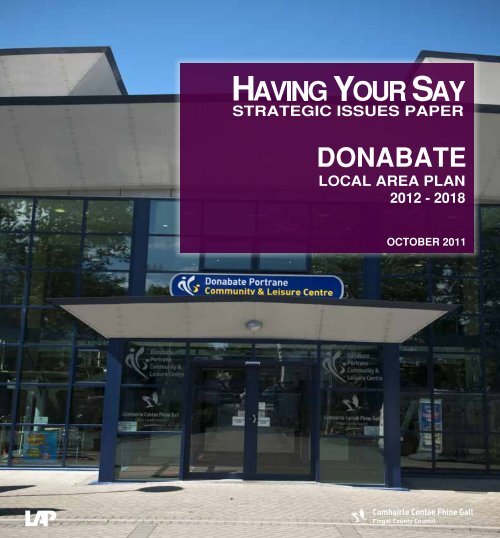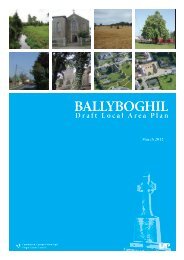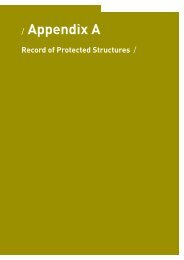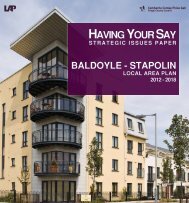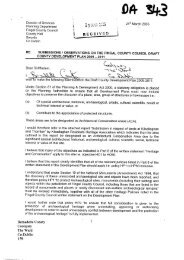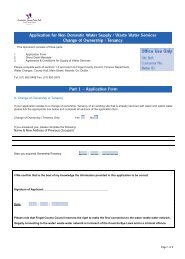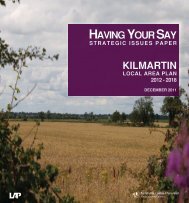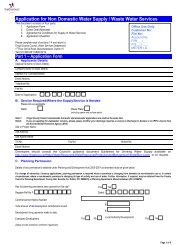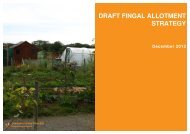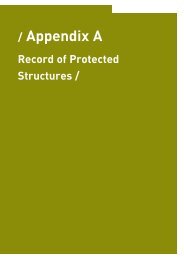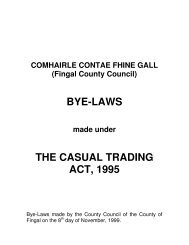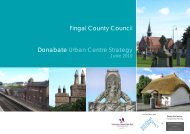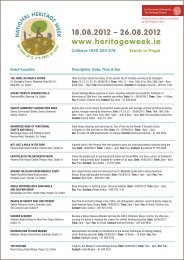Proposed Donabate LAP - Issues Paper - Fingal County Council
Proposed Donabate LAP - Issues Paper - Fingal County Council
Proposed Donabate LAP - Issues Paper - Fingal County Council
Create successful ePaper yourself
Turn your PDF publications into a flip-book with our unique Google optimized e-Paper software.
LOCAL AREA<br />
PLAN PROCESS<br />
WE<br />
ARE<br />
HERE<br />
ANALYSIS OF COMMENTS FROM<br />
DRAFT <strong>LAP</strong> CONSULTATION,<br />
REPORT TO COUNCILLORS<br />
IF MATERIAL<br />
AMENDMENTS<br />
REPEAT PUBLIC<br />
CONSULTATION<br />
STAGES<br />
COUNTY DEVELOPMENT<br />
PLAN<br />
GUIDES <strong>LAP</strong><br />
PROJECT TEAM & SURVEY ANALYSIS,<br />
CREATE WORKING GROUP<br />
- ALL RELEVANT DEPARTMENTS<br />
ISSUES<br />
PAPER<br />
PUBLIC CONSULTATION<br />
ON THE ISSUES PAPER<br />
ANALYSIS ON FINDINGS FROM PUBLIC CONSULTATION<br />
FEEDS INTO PREPARATION OF<br />
DRAFT <strong>LAP</strong><br />
NOTE<br />
<strong>LAP</strong> = Local Area Plan<br />
NIR = Natura Impact Report<br />
AA = Appropriate Assessment<br />
SEA = Strategic Environmental<br />
Assessment<br />
DRAFT<br />
<strong>LAP</strong><br />
ADOPT<br />
OR<br />
AMEND<br />
DRAFT<br />
<strong>LAP</strong><br />
FINAL<br />
<strong>LAP</strong><br />
IMPLEMENTATION<br />
&<br />
MONITORING<br />
PUBLIC<br />
CONSULTATION<br />
ON DRAFT <strong>LAP</strong><br />
STRATEGIC<br />
ENVIRONMENTAL<br />
ASSESSMENT<br />
SCREEN FOR POSSIBLE<br />
SIGNIFICANT<br />
ENVIRONMENTAL<br />
EFFECTS<br />
SCOPING OF<br />
ENVIRONMENTAL<br />
REPORT<br />
PREPARATION<br />
OF<br />
ENVIRONMENTAL<br />
REPORT<br />
ENVIRONMENTAL<br />
REPORT<br />
IDENTIFY ANY SIGNIFICANT<br />
ENVIRONMENTAL EFFECTS OF<br />
SUCH MATERIAL AMENDMENTS<br />
FINAL<br />
ENVIRONMENTAL<br />
REPORT & SEA<br />
STATEMENT<br />
APPROPRIATE<br />
ASSESSMENT<br />
PREPARATION OF SCREENING DOC FOR AA<br />
IS AA REQUIRED YES/NO<br />
IF YES PREPARATION<br />
OF NIR<br />
NIR<br />
ENSURE AA REFLECTS<br />
ANY MATERIAL AMENDMENTS<br />
AA OF PLAN<br />
PRE - DRAFT STAGE<br />
DRAFT STAGE<br />
ADOPTED <strong>LAP</strong>
<strong>Fingal</strong> <strong>County</strong> <strong>Council</strong> is undertaking a review of<br />
the existing <strong>Donabate</strong> Local Area Plan (<strong>LAP</strong>) 2006.<br />
The new <strong>LAP</strong> will provide a 6 year statutory framework<br />
(2012-2018) which will inform and guide development in<br />
the area covered by the <strong>LAP</strong>.<br />
The purpose of this new <strong>LAP</strong> is to provide an updated<br />
strategy on how the area should be developed and<br />
managed in a sustainable way to meet the needs of its<br />
residents. The <strong>LAP</strong> will focus in particular on the policies<br />
and mechanisms that deliver necessary physical, social<br />
and environmental infrastructure for the proper planning<br />
and sustainable development of the local area.<br />
As part of the <strong>LAP</strong> process <strong>Fingal</strong> <strong>County</strong> <strong>Council</strong> is<br />
required to undertake two specific types of environmental<br />
assessment:<br />
- A Strategic Environmental Assessment as<br />
required under the SEA Directive (2001/42/EC),<br />
as transposed into Irish Legislation<br />
- A Habitats Directive Assessment (HDA)<br />
screening, as required under the Habitats<br />
Directive (92/43/EEC), as transposed into Irish<br />
Legislation<br />
The findings and reports of these assessments will be<br />
published by <strong>Fingal</strong> <strong>County</strong> <strong>Council</strong> with the future draft<br />
<strong>LAP</strong>.<br />
The <strong>LAP</strong> will:<br />
o identify future development needs and will<br />
highlight opportunities and constraints associated<br />
with this development;<br />
o outline future housing requirements and the<br />
manner in which it is to be provided,<br />
o develop policies to encourage and support<br />
economic development,<br />
o provide for the conservation of the natural and built<br />
heritage,<br />
o ensure necessary supporting physical and social<br />
Local Area Plan Process<br />
infrastructure is provided in a timely manner;<br />
o support sustainable development practices,<br />
including public transport, sustainable urban<br />
drainage (SUDs), etc.<br />
o inform and guide those planning on investigating<br />
in future commercial or residential development,<br />
infrastructure or services;<br />
o be used as part of the assessment of development<br />
proposals and planning applications.<br />
Why should you get involved?<br />
When it comes to making a submission there is no such<br />
thing as a ‘right’ or ‘wrong’ submission. Local input is<br />
considered vital to the entire <strong>LAP</strong> process and we value<br />
what you have to say. We hope that this issues paper will<br />
initiate interest and debate resulting in constructive,<br />
positive and helpful feedback thus ensuring that the new<br />
<strong>LAP</strong> for <strong>Donabate</strong> reflects how those in the community<br />
and further afield see <strong>Donabate</strong> developing into the<br />
future. Submissions are not limited to the issues raised<br />
in this paper so please feel free to raise any other issue<br />
or area of interest/concern which you consider relevant.<br />
Your Role<br />
The preparation of a Local Area Plan has two phases:<br />
- A Pre-Draft and<br />
- Draft phase<br />
Presently we are at the ‘pre-draft’ stage which is followed<br />
by the preparation and publication of a Draft <strong>LAP</strong>. At<br />
both stages, the planning authority undertakes public<br />
consultation exercises and invites your comments.<br />
If you are interested in the development of the <strong>Donabate</strong><br />
area and wish to contribute to the shaping of its future,<br />
please make a written submission to the Planning<br />
Authority at this before the 15 th of December 2011.<br />
Watch out for…….<br />
For further information check out the council website:<br />
www.fingalcoco.ie/Planning/PlanningItemsOnDisplay/
<strong>Fingal</strong> <strong>County</strong> <strong>Council</strong> is starting the review of the<br />
Local Area Plan for <strong>Donabate</strong> in order to provide<br />
a statutory framework for the proper planning and<br />
sustainable development for the town of <strong>Donabate</strong><br />
and in particular, for the four tracts of undeveloped<br />
residential lands (zoned Objective RA – ‘to provide<br />
for new residential communities in accordance with<br />
approved local area plans and subject to the provision<br />
of the necessary social and physical infrastructure’) on<br />
the western, northern, eastern and southern sides of the<br />
town. These lands comprise of:<br />
• c.65.6 hectares of land to the south of the town<br />
and to the north of the Broadmeadow Estuary at<br />
Corballis;<br />
• c.56.7 hectares of development land at<br />
Ballymastone to the east of the town;<br />
• c.5.5 hectares which form a linear strip to the<br />
north of the village known as Rahillion and;<br />
• c.16 hectares to the west of the town on the<br />
northern side of Turvey Avenue.<br />
The first <strong>Donabate</strong> Local Area Plan was adopted on<br />
20 th June 2006. However, over the last five years there<br />
has been relatively limited development in <strong>Donabate</strong>,<br />
with the major landbanks of Corballis, Ballymastone,<br />
Rahillion and Turvey remaining undeveloped. Despite an<br />
active construction sector nationally, and within <strong>Fingal</strong>,<br />
a number of critical infrastructural constraints existed<br />
within <strong>Donabate</strong> preventing significant development,<br />
namely wastewater treatment and the adequacy of the<br />
road network. These two issues have been generally<br />
addressed with the construction of a new waste water<br />
treatment plant at Portrane and with the grant of planning<br />
permission by An Bord Pleanála for the proposed<br />
Introduction<br />
<strong>Donabate</strong> Distributor Road (ABP Ref 06F.HA0031).<br />
However, these are not the only issues requiring<br />
resolution if <strong>Donabate</strong> is to grow in a sustainable and well<br />
planned manner. The provision of social, community and<br />
recreational infrastructure, protection and enhancement<br />
of <strong>Donabate</strong> town centre, conservation of the<br />
Broadmeadow and Rogerstown Estuaries (both Natura<br />
2000 sites) and ensuring that growth occurs at a pace<br />
which allows any new residential community integrate<br />
into the established residential community of <strong>Donabate</strong><br />
are some of the key issues which require to be addressed<br />
within any new <strong>LAP</strong>.<br />
The plan review and preparation process will be guided<br />
by a wide range of considerations, such as public and<br />
stakeholder consultation, the key issues and needs<br />
identified by local communities and businesses,<br />
employment activities and opportunities, services and<br />
infrastructure available and required, heritage and<br />
environmental issues, statutory requirements including<br />
the new policies and objectives set out in the <strong>Fingal</strong><br />
<strong>County</strong> Development Plan 2011-2018. This Consultation<br />
Document highlights key issues/ questions that may need<br />
to be considered in preparing a new Local Area Plan for<br />
<strong>Donabate</strong>.<br />
02
03<br />
/ KEY ISSUES/QUESTIONS /<br />
What is your vision for <strong>Donabate</strong>?<br />
What should the <strong>LAP</strong> target specifically to help achieve this vision?<br />
How can character be enhanced and developed to ensure a real sense<br />
of place for existing and new residential areas?<br />
Based on progress to date, what do you recognise as positive<br />
achievements in the <strong>Donabate</strong> Area?<br />
What are the main features of <strong>Donabate</strong> that contribute to its<br />
character and make it an attractive place to live, work and visit?<br />
What are the failings to date in your opinion on delivering progress<br />
in the <strong>Donabate</strong> Area and what are your concerns for future<br />
development?<br />
Are the original objectives for this area as identified in 2006 still<br />
relevant and how should they be strengthened, modified or evolved<br />
based on your experiences?
Local Area Plan sets out a vision for the area it<br />
A covers, specifies the nature, extent and quality of<br />
development needed to achieve that vision, while seeking<br />
to protect and enhance the environment and amenities.<br />
It is a positive policy document intended to manage<br />
and influence change in our local surroundings, aiming<br />
to highlight opportunities and identify what needs to<br />
happen, to ensure that the opportunities are realised for<br />
the area. Through the public consultation process a vision<br />
can be formulated, which represents the overarching aim<br />
for <strong>Donabate</strong> into the future (as reflected in the Plan).<br />
The vision for the <strong>Donabate</strong> area in 2006 was to<br />
strengthen the existing urban centre and to create<br />
coherent, sustainable and high quality new residential<br />
areas with a definitive sense of place, functionally<br />
and physically connected to existing development in<br />
<strong>Donabate</strong>. An opportunity was presented to develop a<br />
modern sustainable form of development well connected<br />
to the city centre through public transport and uniquely<br />
located close to rural areas and coastal amenities.<br />
The existing strong identity of <strong>Donabate</strong> was to be<br />
reinforced with the successful integration of the new<br />
community and existing communities in the area. The<br />
objectives of the first plan sought to provide a high<br />
quality mixed type housing at varying densities across the<br />
<strong>LAP</strong> lands, accessibility to public transport, the creation<br />
of a hierarchy of local streets for good permeability<br />
throughout the area, along with a viable mix of<br />
commercial and community uses and high quality public<br />
open space and amenities. Strong emphasis was placed<br />
on the desire to see residential development occur in<br />
tandem with the provision of the necessary community<br />
and physical infrastructure.<br />
Vision for <strong>Donabate</strong><br />
The overarching Development Strategy for <strong>Donabate</strong> as<br />
set out in the <strong>Fingal</strong> <strong>County</strong> Development Plan 2011-<br />
2017 seeks to:<br />
‘Protect and enhance the natural amenities and<br />
heritage of the peninsula by consolidating future<br />
development within well defined town boundaries.<br />
Promote the development of a vibrant town core<br />
by providing a high quality living environment for<br />
the existing and future population and providing<br />
for the development of the necessary community,<br />
commercial, cultural, social facilities in tandem with<br />
new residential development’.<br />
04
05<br />
/ KEY ISSUES/QUESTIONS /<br />
How should the <strong>LAP</strong> address the needs of the existing and future<br />
population of the <strong>Donabate</strong> area?<br />
What are the important age categories that the <strong>LAP</strong> should address<br />
when analysing social infrastructure (e.g. community and<br />
recreational facilities) and the provision of services?<br />
How can we develop the zoned land banks for residential and other<br />
developments in a way that is beneficial to consolidation of the area?<br />
What steps should be taken to manage the impact of population<br />
growth?
<strong>Donabate</strong> is designated as a Moderate Sustainable<br />
Growth Town in the Metropolitan Area in both<br />
the Regional Planning Guidelines for the Greater<br />
Dublin Area 2010-2022 (RPG’s) and the <strong>Fingal</strong> <strong>County</strong><br />
Development Plan 2011-2017. The role of a Moderate<br />
Sustainable Growth Towns is to strengthen the edges of<br />
the Metropolitan Area by acting as district service centres,<br />
with high quality linkages and facilitating increased<br />
development at nodes on public transport corridors.<br />
From the table below the census population figures for the<br />
years of 1996 and 2002 reveal a very substantial increase<br />
from 1,868 to 3,854 persons. It is evident that a significant<br />
upward trend in the population of the town has continued<br />
since 2002, albeit at a slower rate. It is estimated that the<br />
current population of the town is now 6,230.<br />
1996 2002 2006 2011<br />
POP 1,868 3,854 5,499 *6,230<br />
Increase - 1,986 1,645 731<br />
% Change - 106.3% 42.6% 13.3%<br />
Source: CSO<br />
*based on house counts carried out in June 2011 and an average household size<br />
of 2.8 persons.<br />
Current Situation<br />
As of June 2011 outstanding planning permissions exist<br />
for 172 additional residential units in <strong>Donabate</strong> with<br />
a further 55 units under construction. As provided<br />
for in the <strong>County</strong> Development Plan 2011-2017, the<br />
undeveloped residentially zoned lands (RA and RS)<br />
can provide for a maximum additional 3,151 residential<br />
units deliverable up to 2017. However, given the current<br />
housing market trends it is unlikely that this figure will<br />
be realised during the plan period. Furthermore the<br />
future <strong>LAP</strong> will examine the appropriate phasing to<br />
Population & Housing<br />
ensure that development occurs in tandem with required<br />
infrastructural provision.<br />
While the 2006 <strong>Donabate</strong> <strong>LAP</strong> provided for approximately<br />
5,000 homes on the RA zoned <strong>LAP</strong> lands none of these<br />
units were realised despite the unprecedented housing<br />
boom in <strong>Fingal</strong>. One of the main reasons for the limited<br />
housing growth on the <strong>Donabate</strong> <strong>LAP</strong> lands related to<br />
the infrastructural constraints facing the area namely the<br />
inadequate foul drainage and road infrastructure to cater<br />
for the additional residential development. These issues<br />
have now been addressed with the construction of the<br />
upgraded Portrane Waste Water Treatment Plant which<br />
is due to come into operation in February 2012 and the<br />
granting by An Bord Pleanála for Phase 1 of the <strong>Donabate</strong><br />
Distributor Road in July 2011.<br />
06
07<br />
/ KEY ISSUES/QUESTIONS /<br />
What housing types and densities are appropriate for the <strong>LAP</strong> lands<br />
in <strong>Donabate</strong> generally?<br />
What is the best way to accommodate the future housing needs of<br />
<strong>Donabate</strong>, to ensure that the needs of different groups of people i.e.<br />
elderly, mobility impaired and first time buyers can be adequately<br />
catered for?<br />
Are live-work units (e.g. dwellings with artists’ studios or crafts<br />
workshops) a viable option in the area? Where and how should they<br />
be provided?<br />
How can innovative and contemporary designs be encouraged and<br />
realised in <strong>Donabate</strong>?<br />
How should we seek to integrate the established residential areas<br />
with the new development areas being created?<br />
What contributes to an attractive residential layout and best creates<br />
a distinctive character and sense of place in the area?<br />
What are the examples of good housing and urban design in<br />
<strong>Donabate</strong>?
The Regional Planning Guidelines and the <strong>Fingal</strong><br />
<strong>County</strong> Development Plan 2011-2018 aim to secure<br />
the sustainable growth of key towns such as <strong>Donabate</strong>.<br />
This means ensuring the facilitation of new sustainable<br />
residential neighbourhoods in a sequential manner,<br />
as outlined in the Department of the Environment,<br />
Community and Local Governments Guidelines for<br />
Planning Authorities entitled ‘Sustainable Residential<br />
Development in Urban Areas’, and delivering a quality of<br />
life in terms of amenity, convenience and safety. It also<br />
means that new neighbourhoods should integrate into the<br />
established surroundings and promote social inclusion,<br />
while providing a good range of community and support<br />
services in appropriate, accessible locations.<br />
New neighbourhoods should also be connected, legible,<br />
attractive, well designed with a variety of adaptable<br />
dwelling types/sizes and densities, providing a sense of<br />
place and a high quality public realm. The proposed <strong>LAP</strong><br />
is an opportunity to enhance the character and identity<br />
of <strong>Donabate</strong>. The future development of the residentially<br />
zoned <strong>LAP</strong> lands opens up opportunities to create a new<br />
urban landscape through the creation of a new built form<br />
and an enhanced environment. The principles of good<br />
urban design and the future built form are fundamental<br />
elements to creating; maintaining and enhancing a sense<br />
of place, ensuring that <strong>Donabate</strong> remains an attractive<br />
place to live, work and visit.<br />
New residential areas also provide the opportunity to<br />
minimise car-based transport demand by providing a<br />
mix of appropriate uses at the right location, prioritising<br />
walking, cycling and public transport and working<br />
towards reducing car dependency.<br />
Developing Sustainable New<br />
Residential Communities<br />
All planning applications for new development will be<br />
required to comply with the development management<br />
standards for residential and commercial development<br />
as the <strong>Fingal</strong> <strong>County</strong> Development Plan, 2011-2017.<br />
The <strong>LAP</strong> will also consider a hierarchy of heights and<br />
appropriate densities in response to the character of the<br />
plan area and having regard to the established residential<br />
areas, community uses in the town and any negative<br />
impact on the sensitive landscape surrounding <strong>Donabate</strong>.<br />
The Plan can also stipulate design criteria particular to<br />
<strong>Donabate</strong>. These can reflect the special character and<br />
unique setting of <strong>Donabate</strong> and seek to integrate new<br />
development with the established character of the town.<br />
08
09<br />
/ KEY ISSUES/QUESTIONS /<br />
What retail uses are appropriate in the <strong>LAP</strong> lands in order to ensure<br />
that they do not detract from the existing town centre?<br />
How can future development support the continued enhancement<br />
of existing town centre facilities?<br />
How can the <strong>Donabate</strong> <strong>LAP</strong> support new businesses and different<br />
types of employment?<br />
How can we enhance the visitor experience of architectural heritage/<br />
natural heritage sites?<br />
Do we need more information points and interpretation/<br />
educational services and, if so, where would be appropriate?<br />
How can the tourism potential of the <strong>Donabate</strong> area be maximised?<br />
Is the existing <strong>Donabate</strong> Urban Centre Strategy relevant/helpful?
The primary retail area in <strong>Donabate</strong> is the town centre<br />
which has developed successfully in recent years.<br />
The town centre is also an important focus for a range<br />
of commercial, service and community activities. This is<br />
reinforced through the <strong>Donabate</strong> Urban Centre Strategy<br />
2010 which provides detailed guidance and policy on<br />
the future enhancement of area. The development of<br />
retail and non-retail services in the town centre and any<br />
proposed new local neighbourhood centres needs to be<br />
carefully planned and managed in order to protect and<br />
enhance the town’s vitality and viability.<br />
Given the scale of the residentially zoned <strong>LAP</strong> lands<br />
an appropriate level/form of retail provision will be<br />
necessary. However, it is important this be of a scale and<br />
function which will not detract from the existing urban<br />
core. It is a priority of the <strong>Council</strong> to protect and reinforce<br />
the town’s retail, commercial and service function as it<br />
is critical to maintaining a vibrant, diverse and effective<br />
town centre. Encouraging high quality designs and<br />
facilitating an appropriate mix of uses as provided for in<br />
the Urban Centre Strategy helps to ensure that the town<br />
centre provides a suitable focus for creating sustainable<br />
communities.<br />
In terms of employment it is envisaged that <strong>Donabate</strong> will<br />
continue to have a strong role as a commuter location<br />
within Dublin Metropolitan Area. It is important that<br />
there are positive objectives to provide for and support<br />
the development of local, appropriately scaled businesses<br />
within <strong>Donabate</strong> town to ensure a local employment base.<br />
At present the employment opportunities within the<br />
town are somewhat limited however this may change<br />
in the future with an increase in population and the<br />
Retail, Economic Development and<br />
Tourism<br />
resultant need for local services provision. To facilitate<br />
local employment provision consideration may need<br />
to be given to the design of dwellings with additional<br />
space for home-office use and also the provision of small<br />
business units.<br />
As a tourist destination, <strong>Donabate</strong> being an attractive<br />
coastal community with a number of excellent golf courses<br />
is well placed to take advantage of, and benefit from, the<br />
important contribution that tourism can make to a local<br />
economy. There is significant potential for the growth of<br />
tourism and its associated job opportunities within the<br />
town and the surrounding hinterland. Newbridge House,<br />
Gardens and Demesne are one of the main features<br />
within the town. The <strong>Donabate</strong> Peninsula is also a great<br />
destination for those with an interest in wildlife with<br />
Rogerstown Estuary being a notable location for bird<br />
watching enthusiasts.<br />
10
11<br />
/ KEY ISSUES/QUESTIONS /<br />
What type of community facilities and local services are currently<br />
needed in <strong>Donabate</strong> (including the new residential comunities)?<br />
Do the current community facilities cater for all sectors of the<br />
<strong>Donabate</strong> population, for example, the young and elderly<br />
populations of <strong>Donabate</strong>?<br />
Are there adequate schools in the area and are they easily accessible<br />
to the people that they serve?<br />
Are there adequate health and childcare facilities in <strong>Donabate</strong> that<br />
are easily accessible to all?<br />
Where should we locate nursing homes and residential care<br />
facilities?<br />
Can you identify other possible locations appropriate for<br />
community facilities?
Well developed community facilities and<br />
amenities can ensure a good quality of life and<br />
social interaction for all residents of the town and its<br />
hinterland. These amenities can include childcare and<br />
educational facilities, nursing homes and health centres,<br />
libraries, facilities for older people, places of worship and<br />
community halls.<br />
The Regional Planning Guidelines for the Greater Dublin<br />
Area require Planning Authorities to adopt objectives<br />
that provide for the social, community and cultural needs<br />
of all persons and communities through the provision of<br />
well dispersed and easily accessible social and community<br />
infrastructure. These objectives are key contributory<br />
factors in ensuring the delivery of a high quality of life.<br />
In terms of educational facilities the town is currently<br />
well served by schools, both primary and post-primary,<br />
in the form of:<br />
St. Patrick’s Boys and Girls National Schools which<br />
form part of College Court on the Portrane Road,<br />
<strong>Donabate</strong> Community College and the <strong>Donabate</strong><br />
Portrane Educate Together National School which<br />
have recently relocated to the newly constructed state<br />
of the art campus at Ballisk.<br />
It is the responsibility of the Planning Authority to<br />
reserve sufficient lands to accommodate community<br />
and educational facilities. It is envisaged that any future<br />
requirements for schools which may arise on foot of the<br />
development of the <strong>LAP</strong> lands will be delivered under the<br />
successful <strong>Fingal</strong> Schools Model. This is an arrangement<br />
between the <strong>Council</strong> and the Department of Education &<br />
Skills designed to achieve the dual targets of fast tracking<br />
Education and Community<br />
the early delivery of school sites and the provision of<br />
community facilities as part of the school building<br />
programme. There have been a number of such multiuse<br />
facilities successfully delivered at various locations<br />
throughout the <strong>County</strong> which fulfil the various needs of<br />
different sectors of the population.<br />
The town has well established community facilities in<br />
the form of the <strong>Donabate</strong> Portrane Community and<br />
Leisure Centre which is a state of the art leisure facility<br />
and includes a gym, coffee shop, Montessori and provides<br />
classes and activities for both adults and children. In<br />
addition it boasts a world class astroturf pitch. There are<br />
also a number of crèche and Montessori schools at key<br />
locations throughout the town. The town currently has<br />
two Churches which provide for the religious needs of the<br />
community.<br />
12
13<br />
/ KEY ISSUES/QUESTIONS /<br />
Is there an adequate quantity and quality of play, open space and<br />
recreational facilities in <strong>Donabate</strong>?<br />
Are there deficiencies in the existing open spaces within the Plan<br />
area and if so, where could new parks/open spaces and recreational<br />
areas be located?<br />
How can the Plan utilise and enhance existing amenity areas in the<br />
town and provide for both passive and active recreation?<br />
How do you think the Plan can provide opportunities for good<br />
connectivity for recreational walking and cycling purposes? Is there<br />
any specific location that you feel this Plan can address this issue?
Recreational facilities and open spaces are important<br />
amenities which contribute to the character of an<br />
area and can include passive and active recreational areas,<br />
formal landscaped and natural areas.<br />
Public open space is one of the key elements in defining<br />
the quality of a neighbourhood environment, in relation<br />
to passive and active amenity, and its ecological and<br />
environmental aspects and in this regard <strong>Donabate</strong><br />
currently benefits from a number of valuable amenity<br />
spaces, most notably Newbridge Demesne. Covering an<br />
area of c. 150ha., Newbridge Demesne is characterised by<br />
sports, (playing pitches) recreation and leisure facilities, a<br />
children’s playground along with other visitor attractions<br />
including Newbridge Traditional Farm. There are also<br />
a number of excellent golf courses which are open to<br />
the public and which enjoy a beautiful coastal setting<br />
including the 18 hole Corballis Golf Links which is<br />
operated by <strong>Fingal</strong> <strong>County</strong> <strong>Council</strong> and which is the only<br />
public links course in the country.<br />
Other important amenities include the natural amenities<br />
of the Rogerstown and Malahide Estuaries and their<br />
associated beaches. The quality of these natural heritage<br />
areas spaces enhance and contribute to the character and<br />
visual amenities of the area.<br />
An expanding population generates increased demand<br />
for the provisions of services and amenities and it is of<br />
the utmost importance that these are provided in tandem<br />
with new development. One of the key issues of this<br />
Local Area Plan review is to address the delivery of these<br />
essential facilities as new communities are created.<br />
Open Space & Recreation<br />
14
15<br />
/ KEY ISSUES/QUESTIONS /<br />
How do we make sure that development respects our natural<br />
heritage, promotes biodiversity and does not lead to the loss of, or<br />
damage to, our natural heritage?<br />
How do we best protect and manage the environmental resources<br />
available to deliver environmental, social and economic benefits and<br />
services to the local area?<br />
How can the development process highlight the natural assets of the<br />
local area to a better extent?<br />
What types of new routes and connections would best facilitate<br />
access to the Rogerstown and Malahide estuaries in a sustainable<br />
and sensitive manner?<br />
What types of uses, activities or initiatives would enhance and<br />
protect the biodiversity value of the estuary areas, whilst facilitating<br />
access and involvement by the local community?<br />
What greening initiatives should be considered for the area and<br />
incorporated in new developments?
The term Green Infrastructure is used to describe<br />
the interconnected networks of land and water all<br />
around us that sustain environmental quality and enrich<br />
our quality of life. This includes the nature conservation<br />
areas, parks, open space, rivers, floodplains, wetlands,<br />
woodlands, farmland and coastal areas which surround<br />
and are threaded through our towns and urban areas.<br />
The principles of Green Infrastructure planning are<br />
central to sustainable land use and development. Green<br />
Infrastructure is a ‘quality of life’ issue as it contributes to<br />
the protection of both the urban and rural environments<br />
- for people, for biodiversity and for our ecosystems.<br />
The <strong>Fingal</strong> Development Plan 2011-2017 and the <strong>Fingal</strong><br />
Biodiversity Action Plan both seek to establish wildlife<br />
corridors and green networks across the county. The<br />
challenges we are now facing is how to balance the<br />
development of compact urban areas, through the<br />
intensification of mixed-use areas built around the<br />
public transport system, with more sustainable forms of<br />
development in order to encourage approaches which<br />
effectively work with nature.<br />
Natural heritage in <strong>Donabate</strong> includes a wide range of<br />
natural features that make an essential contribution to the<br />
environmental quality, ecological biodiversity, landscape<br />
character, visual amenity, recreational activities, public<br />
health and investment potential of the town. There<br />
are a number of designated sites of both national and<br />
international importance adjacent to <strong>Donabate</strong>:<br />
• Malahide Estuary is a Natura 2000 site<br />
(Designated as a Special Protection Area;<br />
Candidate Special Area of Conservation), <strong>Proposed</strong><br />
Natural Heritage Area and Ramsar site (sites<br />
designated pursuant to the Ramsar Convention).<br />
Green Infrastructure, Biodiversity &<br />
Landscape<br />
•Rogerstown Estuary is a Natura 2000 (Designated<br />
as a Special Protection Area; Candidate Special Area<br />
of Conservation), <strong>Proposed</strong> Natural Heritage Area<br />
and Ramsar site (sites designated pursuant to the<br />
Ramsar Convention). It is also a statutory Nature<br />
Reserve.<br />
Accordingly the estuaries are protected under national<br />
laws, EU Directives and International Conventions. In<br />
formulating policies and objectives for the new Plan,<br />
<strong>Fingal</strong> <strong>County</strong> <strong>Council</strong> must comply with the EU Habitats<br />
and Birds Directives as well as national legislation<br />
such as the European Communities (Natural Habitats)<br />
Regulations, 1997 and the more recent Planning and<br />
Development (Amendment) Act 2010 and Environment<br />
(Miscellaneous Provisions) Act 2011.<br />
The <strong>Fingal</strong> <strong>County</strong> Development Plan also identifies<br />
Ecological Buffer Zones to protect the ecological integrity<br />
of the nationally and internationally designated sites<br />
by providing suitable habitat for key species such as<br />
birds, by providing for compatible land-uses around the<br />
designated sites. It is envisaged that around the estuaries<br />
the buffer zones can provide for recreational uses, are<br />
important for coastal flood protection and for climate<br />
change adaptation.<br />
In addition, Newbridge Demesne plays an important biodiversity<br />
role. Taking into account the protected status<br />
of the estuaries and the existing amenity of Newbridge<br />
Demesne we must now seek to ensure that these areas can<br />
be enhanced and protected in any future development.<br />
In terms of landscape, the <strong>Fingal</strong> Development Plan<br />
2011-2017 classifies landscapes according to their<br />
16
Green Infrastructure, Biodiversity &<br />
Landscape<br />
17<br />
landscape types, values and sensitivity. The Rogerstown<br />
and Malahide estuaries enjoy an Estuary Character Type<br />
which is categorised as having an exceptional value,<br />
recognised by the EU designations (SAC & SPA) that<br />
apply to each in additional to national designations such<br />
as proposed Natural Heritage Areas. The aesthetic quality<br />
of the estuaries is also rated as outstanding. The landscape<br />
sensitivity designations in <strong>Donabate</strong>, particularly on<br />
lands adjacent to the estuaries, are determined as being<br />
highly sensitive to development.<br />
In overall terms the landscape, natural environment,<br />
and biodiversity are a valuable resource, which can be<br />
vulnerable to the effects of new development. In this<br />
regard, it is imperative to focus on maintaining and<br />
improving these resources and ensure that development<br />
is planned and managed so that it does not result in<br />
diminishing these natural assets.
Photo Courtesy of Clive Timmons<br />
18
19<br />
/ KEY ISSUES/QUESTIONS /<br />
What aspects of the built heritage in <strong>Donabate</strong> do you consider<br />
important and which should be protected from inappropriate<br />
development?<br />
How can a balance be achieved between protecting our built<br />
heritage and at the same time providing for the development and<br />
future needs of the town?<br />
How can the <strong>Donabate</strong> <strong>LAP</strong> contribute to the protection and<br />
appreciation of protected structures and archaeological sites?<br />
How can we make local heritage more visible and accessible?<br />
Is there anything, which you feel is worthy of protection in <strong>Donabate</strong><br />
which is currently not protected?
Structures and places acquire character and special<br />
interest over time through their continued existence<br />
and familiarity. The built heritage includes both<br />
architectural and archaeological heritage and <strong>Donabate</strong><br />
has a number of significant elements of both that form<br />
part of the history, heritage and character of the town.<br />
The <strong>Fingal</strong> <strong>County</strong> Development Plan incorporates the<br />
Record of Protected Structures (RPS), which protects<br />
structures which are considered to be of special<br />
architectural, historical, archaeological, artistic, cultural,<br />
scientific, technical interest or value. There are a wealth<br />
of protected structures located on/or adjacent to the<br />
residentially zoned lands which are subject to the <strong>LAP</strong>.<br />
Specifically,<br />
• No. 502 a Railway Bridge, Corballis Road Kilcrea<br />
No. 505, a Vernacular House & Former Forge at<br />
Hearse Road<br />
• No. 503 an earthwork site at Corballis Road (also a<br />
Recorded Monument).<br />
• No. 504 Corballis House & Out offices<br />
• No. 517 off Beverstown Road which is identified as<br />
an archaeological site that potentially was a<br />
harbour.<br />
• No. 518 a Windmill (in ruins) off Beverstown<br />
Road, Rahillion.<br />
Nos. 517 & 518 are also afforded the dual protection of<br />
being listed National Monuments under Section 12 of the<br />
National Monuments (Amendment) Act, 1994.<br />
<strong>Donabate</strong> also has two designated Architectural<br />
Conservation Areas (ACAs), which seeks to protect the<br />
special character of the demesne landscapes in the area.<br />
Heritage & Built Environment<br />
Specifically, Newbridge Demesne to the west of the town<br />
and St. Ita’s Demesne to the southeast enjoy ACA status.<br />
Significant works to a Protected Structure or to the<br />
exterior of a building/structure within an ACA require<br />
planning permission. Buildings of local significance<br />
which retain traditional features also contribute to local<br />
distinctiveness and identity. However, the sustainable<br />
renovation, reuse, extension and, where appropriate,<br />
sympathetic development of existing buildings/structures<br />
which are designated as Protected Structures can help<br />
to ensure that the built heritage can be enjoyed and<br />
continued to be used into the future.<br />
20
21<br />
/ KEY ISSUES/QUESTIONS /<br />
What transport objectives should be included in the Plan? Which<br />
objectives should take priority?<br />
What improvements could be made to public transport links and<br />
how could linkages to the train station at <strong>Donabate</strong> be<br />
improved?<br />
What measures are needed to create a safe, good quality and<br />
attractive streets for people to move around, socialise and to do<br />
business?<br />
How can the use of public transport, cycling and walking be<br />
promoted and the use of the private motor car be reduced?<br />
How can walking, cycling and facilities for the elderly and<br />
mobility impaired be improved?<br />
Where should access points to the <strong>LAP</strong> lands, from the town centre<br />
and surrounding residential areas be reserved and where can<br />
existing linkages be improved?
<strong>Donabate</strong> is close to a number of nationally important<br />
transport links including the M1, Dublin-Belfast<br />
Railway Line, Dublin Port and Dublin Airport. The<br />
existing road network of <strong>Donabate</strong> consists of two major<br />
road, the R126 (Hearse Road) from Swords/M1 in the<br />
southwest and the R126 Portrane Road in the northeast.<br />
These roads connect near <strong>Donabate</strong> Train Station at<br />
the humpback bridge, the only crossing point over the<br />
Dublin-Belfast Line. Improving transport linkages,<br />
better use of the existing rail and bus network along with<br />
alternative ways of travelling such as cycling and walking<br />
will be encouraged through the plan which will help to<br />
promote a more sustainable way of living. New residential<br />
communities will be closely linked to and integrated with<br />
the existing town.<br />
An infrastructural requirement of the 2006 <strong>Donabate</strong><br />
<strong>LAP</strong> was that, with the exception of 300 units on the<br />
northern side of Balcarrick Road and development of<br />
lands at Rahillion and Turvey, the new distributor road<br />
between the Hearse Road and the Portrane Road would<br />
be completed before the development of the lands at<br />
Corballis or Ballymastone can take place. In July 2011 An<br />
Bord Pleanála granted permission for Phase 1 of <strong>Donabate</strong><br />
Distributor Road which will comprise of the construction<br />
of a distributor road at <strong>Donabate</strong> town approximately 4<br />
kilometres in length, construction of a new bridge over<br />
the Dublin to rail line; and the provision of associated<br />
pedestrian and cycle facilities. When completed, this<br />
road will form a by-pass around the town centre thereby<br />
significantly easing traffic congestion.<br />
Ease of movement into and out of an area has many<br />
benefits, such as fostering economic competitiveness,<br />
reducing greenhouse gases and noise pollution,<br />
Transportation and Movement<br />
promoting healthier lifestyles and providing maximum<br />
transport efficiency with the least environmental impact.<br />
The new <strong>LAP</strong> will continue to promote integrated land<br />
use and transportation planning to further support and<br />
encourage more sustainable modes of travel. This includes<br />
ensuring that the design and layout of new developments<br />
provide permeability, linkages and connectivity to their<br />
surrounding areas, thereby minimising local trips by the<br />
private car.<br />
An important consideration is the relationship between<br />
public transport infrastructure and planned future<br />
development. A Greater Dublin Area: Draft Transport<br />
Strategy 2011-2030 has been prepared by the National<br />
Transport Authority. This strategy identifies the extension<br />
of DART services to Balbriggan including <strong>Donabate</strong><br />
as a key objective. Importantly, emphasis is also placed<br />
on the integration of land use and transport planning<br />
through increasing the density of development proximate<br />
to enhanced public transport. Similarly, the Regional<br />
Planning Guidelines for the Greater Dublin Area<br />
also seek that public transport provision is supported<br />
by appropriate residential density in new housing<br />
developments.<br />
We would like to hear your views on the future provision<br />
of public transport, additional car parking provisions,<br />
creation of new links to the centre of <strong>Donabate</strong> Town,<br />
the existing train station and existing strategic transport<br />
corridors in and around the area, as well as the future<br />
provision of walkways and expanded provision of cycle<br />
tracks to serve the town.<br />
22
23<br />
/ KEY ISSUES/QUESTIONS /<br />
What are the main infrastructure problems that should be<br />
considered in the Draft Local Area Plan?<br />
What measures should be included in the Plan to ensure that waste<br />
is reduced and disposal of waste is better managed? Is there a need<br />
for additional recycling areas?<br />
What are the energy networks and telecommunication needs within<br />
the Plan area?<br />
Is there water supply or water quality issues experienced in<br />
<strong>Donabate</strong> at present?<br />
How can sustainable drainage systems be further encouraged and<br />
utilised within <strong>Donabate</strong>?<br />
How can the <strong>Donabate</strong> <strong>LAP</strong> encourage energy conservation and<br />
energy efficiency and the provision and development of alternative<br />
sources of renewable energy?<br />
Do you see <strong>Donabate</strong> becoming a ‘green hub’ and if so how do you<br />
see this being achieved?
The sustainable growth of <strong>Donabate</strong> is dependent on<br />
the satisfactory provision of service infrastructure,<br />
utilities, energy, and communication networks. There is<br />
a need to plan for all of these elements so as to ensure<br />
that there is adequate availability to support future<br />
sustainable development. The phasing of development<br />
in tandem with the provision of necessary infrastructure<br />
and utilities will also be critical to the future sustainable<br />
development of the town.<br />
Wastewater Disposal<br />
The original <strong>Donabate</strong> Local Area Plan was prepared and<br />
adopted by <strong>Fingal</strong> <strong>County</strong> <strong>Council</strong> in 2006. However,<br />
the development potential of the plan lands has not been<br />
realised partially due to foul water capacity constraints.<br />
The new Wastewater Treatment Plant which will serve<br />
<strong>Donabate</strong>, Portrane and Lusk and Rush to the north is<br />
due for completion in February 2012. Furthermore,<br />
the pumping station at the junction of the Portrane<br />
and Ballisk Road is almost complete. Once completed<br />
this infrastructure will ensure that sewage generated<br />
is pumped to and disposed of at a modern wastewater<br />
collection and treatment plant which complies with the<br />
E.U. Urban Waste Water Directive.<br />
While the new treatment plant and pumping station will<br />
be up and running in the first quarter of 2012 the sewer<br />
network in <strong>Donabate</strong> will still require to be expanded and<br />
upgraded with this likely to take place in tandem with<br />
future developments.<br />
Surface Water Disposal and Sustainable urban<br />
Drainage Systems (SuDs)<br />
Surface water must be disposed of in a controlled and<br />
sustainable manner. Traditional drainage practices rely<br />
Utility, Infrastructure and<br />
Communications<br />
on the conveyance of surface water run-off through<br />
pipes to local streams and watercourses. This can lead to<br />
a variety of problems such as flooding, soil erosion and<br />
the contamination of watercourses by pollutants (such as<br />
detergents, pesticides and herbicides). Sustainable urban<br />
Drainage Systems (SuDs) aim curb these practices and<br />
instead to maintain or restore a more natural drainage<br />
regime on site, so that the impact of development on<br />
downstream flooding and water quality is minimised.<br />
Examples of potential SuDs measures include permeable<br />
surfaces, rainwater harvesting, green roofs, filter drains,<br />
constructed wetlands and retention ponds (where<br />
appropriate).The implementation of SuDS will be<br />
obligatory in new developments within the <strong>LAP</strong>.<br />
Water Supply and Quality<br />
The availability of a water supply of sufficient quality<br />
and quantity is essential for public health purposes and<br />
sustainable growth. Similarly water conservation is also<br />
essential to prevent the unnecessary loss of this precious<br />
resource. Presently, the water supply serving <strong>Donabate</strong><br />
comes from the Liffey at its abstraction point at Leixlip and<br />
the existing network is adequate to meet the anticipated<br />
development needs for the lifetime of the Plan.<br />
The EU Water Framework Directive 2000/60/EC requires<br />
member states to ensure that all their waters (including<br />
surface and groundwater) achieve at least ‘good status’<br />
by 2015 and to ensure that the current status does not<br />
deteriorate in any waters. The Eastern River Basin<br />
Management Plan has been prepared and recognises the<br />
need to integrate water protection measures with land use<br />
planning at regional and local level.<br />
24
Utility, Infrastructure and<br />
Communications<br />
25<br />
Waste Management<br />
The Waste Management Plan for the Dublin Region<br />
2005-2010 (currently under review) provides policy<br />
guidance on waste management in <strong>Fingal</strong>. Best practice<br />
in terms of waste management recommends that as much<br />
waste as possible is dealt with through reduction, reuse<br />
and recycling, with as little as possible remaining to be<br />
disposed of to landfill. A sustainable waste management<br />
system is necessary to attract commercial and industrial<br />
development and for promoting tourism opportunities<br />
within the town and this will be supported by the Local<br />
Area Plan.<br />
Energy Infrastructure and Telecommunications<br />
Developments require adequate power, energy and<br />
telecommunications services, including electricity, gas<br />
supply, telephone services and broadband, which are<br />
provided by a number of different service providers. Local<br />
Area Plan policies and objectives will seek to facilitate the<br />
continuous development of same at appropriate locations,<br />
subject to proper planning and sustainable development<br />
considerations.
27<br />
/ KEY ISSUES/QUESTIONS /<br />
How is climate change impacting on <strong>Donabate</strong>? How will it impact<br />
in the future?<br />
How should the interface between the sea and land be treated within<br />
the <strong>LAP</strong> lands?<br />
How can the coastline be better protected, yet utilised sustainably?<br />
How can renewable energy sources be better promoted in <strong>Donabate</strong>?<br />
Are there energy initiatives that could be introduced into<br />
<strong>Donabate</strong> and facilitated through the <strong>LAP</strong>?<br />
What areas in <strong>Donabate</strong> town, if any, have experienced flooding?<br />
What have been the causes of flooding?<br />
What measures should be included in the <strong>LAP</strong> to deal with flood<br />
risk and assessment?
The impacts of climate change, partly due to manmade<br />
actions present very serious global risks and<br />
threaten the basic components of life, including health,<br />
access to water, food production and the use of land.<br />
The way in which towns such as <strong>Donabate</strong> develop<br />
into the future can have a huge impact at local level on<br />
reducing the impacts of climate change. This can include<br />
measures such as:<br />
• promoting reduced travel demand by integrating<br />
land use and transportation,<br />
•encouraging passive solar design and energy<br />
efficient buildings,<br />
• facilitating an increase in the modal share of<br />
sustainable modes of travel,<br />
• promoting waste reduction,<br />
• the re-use of existing building stock and adopting<br />
appropriate treatments of the land and sea<br />
interface to deal with the impacts of climate<br />
change, such as rising sea levels.<br />
Renewable energy encompasses the energy flows that<br />
occur naturally and repeatedly in the environment such<br />
as the sun, wind, fall of water and the oceans. Geothermal<br />
energy, plant material and combustible or digestible<br />
agricultural, domestic or industrial waste may also be<br />
regarded as renewable sources of energy. In the context<br />
of an urban area such as <strong>Donabate</strong>, it may be appropriate<br />
to investigate the potential for the use of renewable<br />
energy sources and the incorporation of energy efficiency<br />
measures into the <strong>Donabate</strong> <strong>LAP</strong> such as:<br />
• a requirement that development utilises renewable<br />
energy supply systems to meet an agreed<br />
minimum percentage of the buildings space<br />
and water heating requirements or alternatively;<br />
Climate Change, Renewable Energy &<br />
Flooding<br />
• the use of measure such as the installation of a<br />
District Heating System which works like<br />
a domestic central heating system only on a larger<br />
scale.<br />
Flooding is a natural process of the hydrological cycle<br />
that can happen at any time, in a wide variety of locations<br />
and can be caused by prolonged, intense and localised<br />
rainfall. Development, if not managed appropriately, can<br />
exacerbate the natural flooding process. The Department<br />
of the Environment and the OPW have published The<br />
Planning System and Flood Risk Management: Guidelines<br />
for Planning Authorities 2009, which require Planning<br />
Authorities to ensure that, where relevant, flood risk is a<br />
key consideration in preparing a <strong>LAP</strong>.<br />
In response to the requirements of the EU Floods<br />
Directive (2007) <strong>Fingal</strong> <strong>County</strong> <strong>Council</strong>, along with<br />
Meath <strong>County</strong> <strong>Council</strong> and the Office of Public Works<br />
(OPW) have commissioned consultants to undertake a<br />
catchment based flood risk assessment and management<br />
study of 19 rivers and streams (<strong>Fingal</strong> East Meath<br />
Flood Risk Assessment and Management Study (FEM-<br />
FRAMS)). The FEMFRAMS study will provide a detailed<br />
analysis of the flood risks along the <strong>Fingal</strong> coastline.<br />
Draft Flood Risk areas for both fluvial and coastal<br />
flooding are shown on www.fingaleastmeathframs.ie<br />
As part of the preparation of the Local Area Plan for<br />
<strong>Donabate</strong>, <strong>Fingal</strong> <strong>County</strong> <strong>Council</strong> will include policies<br />
& objectives to support the reduction of the impacts<br />
of climate change, energy conservation and greater<br />
use of renewable energy sources/technologies as well<br />
as identifying measures to minimise the potential for<br />
flooding in the area.<br />
28
29<br />
/ KEY ISSUES/QUESTIONS /<br />
What are the most important parts of <strong>Donabate</strong>’s<br />
environment?<br />
What do you think are the big environmental issues (strengths and<br />
threats) facing <strong>Donabate</strong>?
Strategic Environmental Assessment<br />
The Strategic Environmental Assessment (SEA)<br />
process is the formal systematic evaluation of the likely<br />
significant environmental effects of implementing a plan<br />
or programme before a decision is made to adopt the<br />
plan or programme. SEA is based on decision making at<br />
a strategic level. There are a number of steps involved in<br />
this process, including the following;<br />
• Preparation of an environmental report where the<br />
likely significant environmental effects<br />
are identified and evaluated;<br />
• Consultation with public and environmental<br />
authorities (Environment Protection Agency,<br />
Department of Environment, Heritage and Local<br />
Government and Department of<br />
Communications, Energy and Natural Resources);<br />
• Incorporation of the findings of the report and the<br />
outcome of the consultations in deciding whether<br />
to adopt or modify the Draft Development Plan;<br />
• Publication of the decision on the adoption of the<br />
plan and outline how SEA influenced the outcome;<br />
The environmental report is the core of the SEA process.<br />
The environment report will contain the likely significant<br />
effects on the environment of implementing the plan<br />
which must be identified, described and evaluated in the<br />
report. In determining the effects on the environment the<br />
following will be considered:<br />
• Population<br />
• Biodiversity<br />
• Human health<br />
• Flora/Fauna<br />
• Soil<br />
Strategic Environmental Assessment<br />
& Appropriate Assessment<br />
• Water<br />
• Climate Factors<br />
• Material Assets<br />
• Cultural Heritage<br />
The interaction of all of the above will also be taken into<br />
account.<br />
Given the environmental sensitivities of <strong>Donabate</strong> and<br />
its environs, <strong>Fingal</strong> <strong>County</strong> <strong>Council</strong> has decided to<br />
undertake a SEA as part of this plan. In this regard, the<br />
Draft <strong>LAP</strong> will be accompanied by an ‘Environmental<br />
Report’ evaluating the potential impacts of the proposed<br />
plan on the environment. This Report will be available to<br />
view at the same time as the draft plan. Any comments in<br />
relation to the preparation of the SEA are welcome.<br />
EU Habitats Directive ‘Appropriate Assessment’<br />
‘Appropriate Assessment’ (AA) is a process which<br />
comprises the assessment, based on scientific knowledge,<br />
of the potential impacts of the plan on the conservation<br />
objectives of any Natura 2000 1 site and the development,<br />
where necessary, of mitigation or avoidance measures to<br />
preclude negative effects. This is understood to include<br />
Natura 2000 Sites not situated in the area encompassed<br />
by the Draft Plan or scheme but could potentially be<br />
impacted upon through ‘ex-situ’ impacts which may<br />
include a study area up to 15km. The impacts assessed<br />
must include the indirect and cumulative impacts of the<br />
plan, considered with any current or proposed activities,<br />
developments or policies which may impact on the<br />
site. It informs plans of the environmental impacts of<br />
alternative actions and contributes to the integration of<br />
environmental considerations into plan making. The most<br />
recent legislation in this area includes the Planning and<br />
1 Natura 2000 sites are sites subject to European designations, normally<br />
known as SAC (Special Area of Conservation) and SPA (Special<br />
Protection Area). These are protected under the Habitats Directive of<br />
1992 (EU directive 92/43/EEC)<br />
30
Strategic Environmental Assessment<br />
& Appropriate Assessment<br />
31<br />
Development (Amendment) Act 2010 and Environment<br />
(Miscellaneous Provisions) Act 2011.<br />
Generally a full Appropriate Assessment comprises of a<br />
number of stages:<br />
Stage 1 Screening to identify the likely impacts on a<br />
Natura Site by a Plan/Project either alone or<br />
in combination with other plans/projects;<br />
Stage 2 Consideration of the impact on the integrity<br />
of the Natura Site of the Plan/Project, either<br />
alone or in combination with other plans/<br />
projects; where there are adverse impacts,<br />
an assessment of the potential mitigation of<br />
those impacts.<br />
Stage3 Assessment of alternative solutions of<br />
achieving the objectives of the project or plan<br />
that avoid adverse impacts on the integrity of<br />
the Natura 2000 site<br />
Stage4 Where no alternative solutions exist and<br />
where adverse impacts remain an assessment<br />
of compensatory measures where, in the<br />
light of an assessment of imperative reasons<br />
of overriding public interest (IROPI), it<br />
is deemed that the project or plan should<br />
proceed.<br />
The Habitats Directive promotes a hierarchy of avoidance,<br />
mitigation and compensatory measures. First, the plan<br />
should aim to avoid any impacts on European sites by<br />
identifying possible impacts early in the plan-making<br />
process and writing the plan in order to avoid such<br />
impacts. Second, mitigation measures should be applied,<br />
if necessary, during the AA process to the point where<br />
no adverse impacts on the site(s) remain. If the plan is<br />
still likely to result in impacts on European sites, and no<br />
further practicable mitigation is possible, then it must<br />
be rejected. If no alternative solutions are identified and<br />
the plan is required for imperative reasons of overriding<br />
public interest (IROPI test) under Article 6(4) of the<br />
Habitats Directive, then compensation measures are<br />
required for any remaining adverse effect.
N<br />
Turvey<br />
Corballis<br />
<strong>Donabate</strong> Aerial Map taken 2009<br />
Rahillion<br />
Ballymastone
Extract from <strong>Fingal</strong> Development<br />
Plan 2011 - 2017
Your submissions may be made in the<br />
following ways listed below:<br />
- By post to<br />
Senior Executive Officer,<br />
Planning and Strategic<br />
Infrastructure Department,<br />
<strong>Fingal</strong> <strong>County</strong> <strong>Council</strong>,<br />
<strong>County</strong> Hall,<br />
Main Street,<br />
Swords,<br />
Co. Dublin.<br />
OR<br />
By email to devplan@fingalcoco.ie<br />
Only submissions that are signed,<br />
addressed and received by the 15 th<br />
December 2011 can be accepted.<br />
All submissions received during this<br />
period will be considered by the <strong>Council</strong><br />
in the drafting of the new Local Area<br />
Plan.


